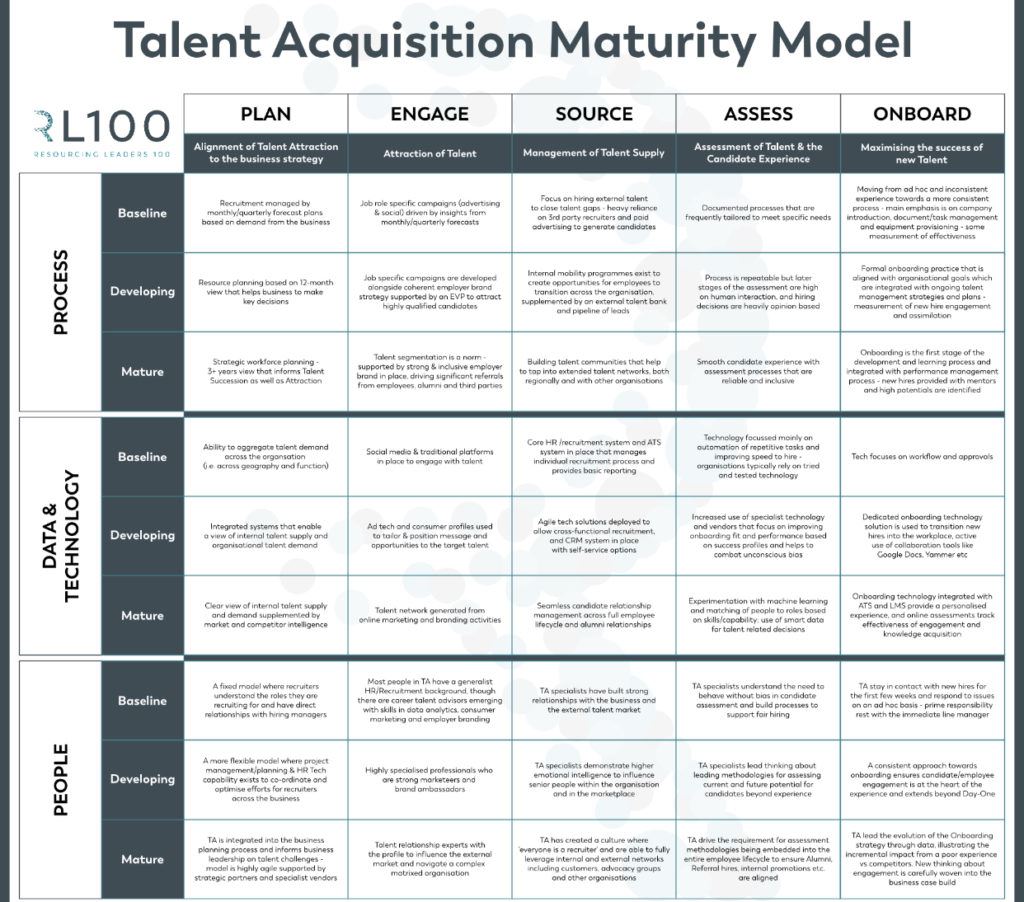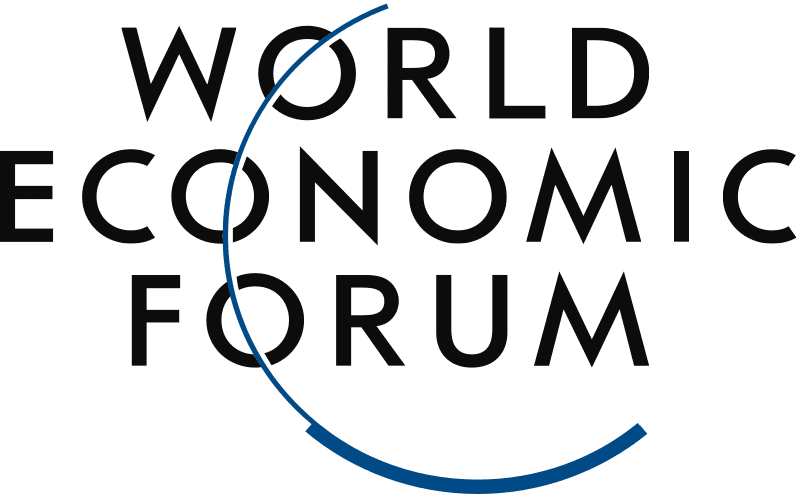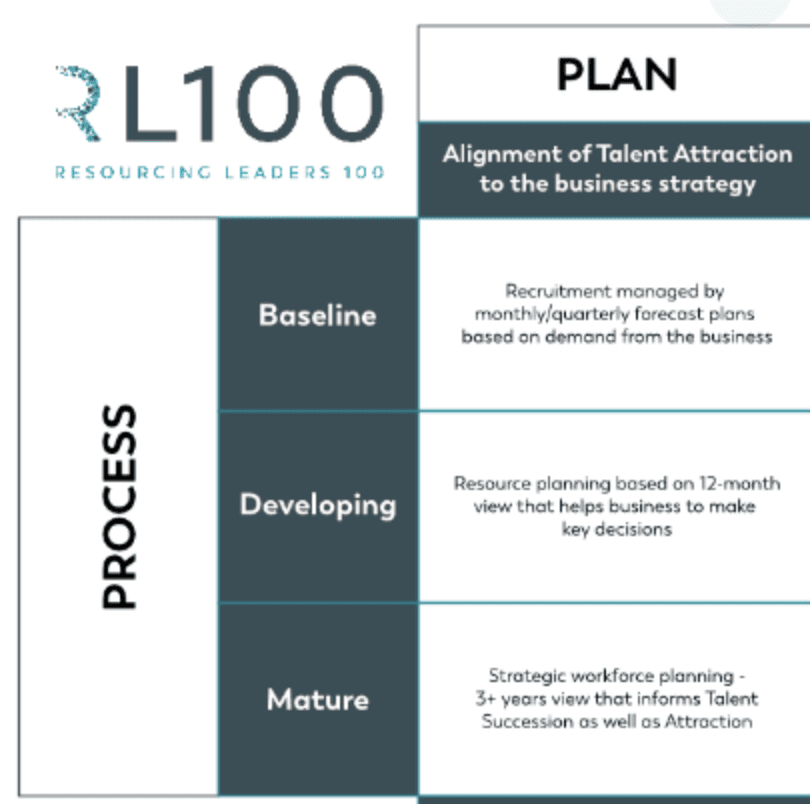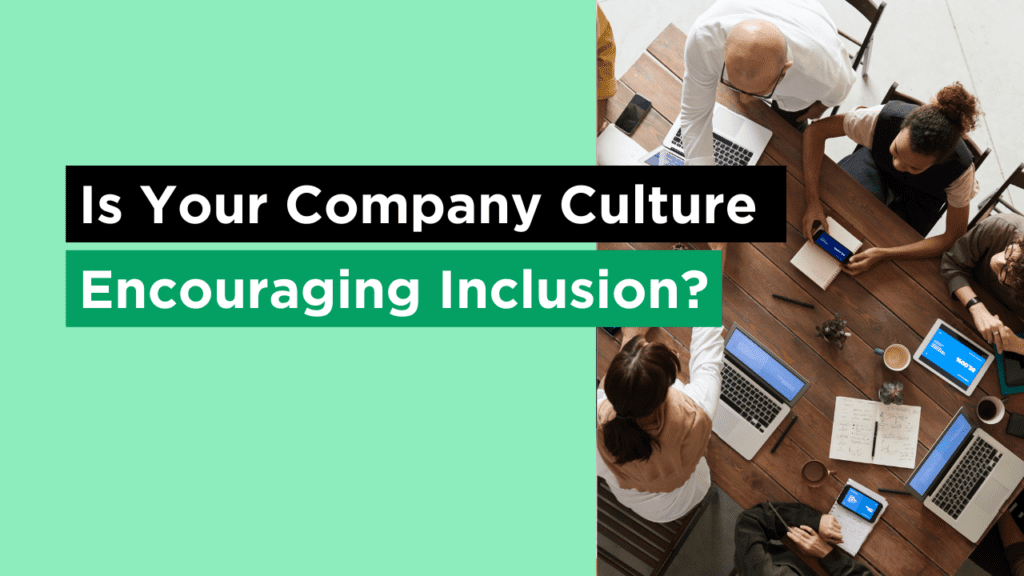To be the first to hear about our latest blogs, whitepaper releases, hiring enablement podcast episodes and get exclusive event invites, join our Exclusive Hiring Enablement Community.
Last week, I saw this graphic from the Resourcing Leadership 100 (RL100) on Talent Acquisition Maturity.

It shows the various stages organisations go through as their talent team matures.
One of the main things that struck me was how increasingly strategic companies get as their talent acquisition maturity model grows. But it also made me think about how difficult it must be for companies to reach that level of maturity.
Talent is a relatively new department, and with budget cuts and hiring freezes, it can be difficult to strategise effectively.
Add in the difficulty in attracting and engaging candidates right now and many teams are struggling with their talent acquisition strategies.
The Talent Acquisition Role is Shifting
Recently, we held a ‘behind closed doors’ discussion with Social Talent’s Johnny Campbell and other leading talent acquisition specialists. A topic that came from the call was the way the talent acquisition role had changed massively during the last few years.
What has Changed in the Talent Acquisition World?
According to the group, talent acquisition roles have started to merge with the talent management role.
Part of the reason for this is an increase in internal mobility. Job roles continually change (look at talent acquisition!) and now, so are people’s positions.
In The WEF’s 2020 Future of Jobs Report, they reported 85 million jobs will be displaced by 2025. And 97 million will be created across 26 countries by 2025.

As AI and machine learning grows, this will continue. Especially with the huge changes brought about by Covid-19 and changes to everyone’s recruitment process.
Now, you need to hire not just for current skills but for their ability to learn and adapt. This means Talent teams need to concentrate on internal progression alongside external hiring.
And with pandemic-related changes – working from home, remote company culture, and virtual training – it’s harder to track engagement and satisfaction too.
Think Outside the Organisation
RL100’s Talent Maturity table is daunting at first glance. To reach a mature level is a long road, especially when roles are changing so rapidly.
But simply managing the baseline means you’re not taking advantage of the benefits of a talent acquisition strategy.
Managing Internal/External Expectations
One of the most difficult areas to work on is external/internal hiring plans that complement each other. Especially while your internal team and hiring managers are tied up with the day-to-day running of whatever area needs it most.
Add in the rapidly-changing job market and evolving needs of potential candidates and it’s an area that’s often overlooked.
Looking outside the business for your talent acquisition strategy
It’s not always possible to mature to a level where every area excels without outside help. Just as some businesses bring in consultants to assist with their marketing, budgeting or their overall business strategies, they’re beginning to bring in outside partners for talent.
It’s Not All Contingent and Retained In The Talent Acquisition Process
For many businesses, outside help doesn’t seem like an option for their talent acquisition strategy. Retained recruiters are too expensive long-term, and contingent recruiters aren’t integrated enough with hiring managers to align with your long-term goals.
Internal teams don’t necessarily trust outside companies, believing they won’t work in the same way they do.
For many TAs, they’re worried potential candidates with top talent won’t get the same treatment, their talent pipeline won’t grow, and prospective employees won’t be up to their own standards.
Change it up
It doesn’t need to be like that.
What if businesses could find a way to work with outside recruiters as a partner, rather than a necessary evil?
The same way consultants work alongside teams in busy periods or times of change.
Partners who could work as an extension of your talent acquisition team and HR department, taking on the difficult roles they don’t have the time or resources to deal with?

Taking your talent acquisition maturity level from baseline to mature…
External Talent Acquisition that Blends Into Your Own Team
By cultivating that relationship, your talent acquisition strategies could become more sophisticated.
Using the knowledge of the recruiter – who is hiring continually – your internal team becomes more informed on the market. (After all, not every business knows what the talent pool looks like outside their country, where they may find skilled talent who can work remotely, or where the best candidates for their specific needs actually are.)
Putting The Candidate Experience First
Many businesses, however, prefer to keep things in-house because they have high candidate experience expectations. Because they have focused heavily on building a top-class employer brand, they want potential employees to have the best experience possible.
And they don’t think an outside talent acquisition team could provide that same experience.
However, a good external team will generally work alongside your existing recruitment and hr department, ensuring they emulate your brand exactly as you would. They’re also able to offer insights into how to conduct indepth searches and outreach, that your team might not have the technology resources or time to complete.
Brand Experience
That way, your top candidates get a fantastic experience of your brand, with best-in-class candidate relationship management.
Meanwhile, your talent team can spend less time actively sourcing and engaging candidates, and more time putting together effective talent acquisition strategies, building the talent pipeline, improving their talent maturity model, and working on bettering internal skill sets. In other words, future-proofing your talent acquisition.

Going Above and Beyond
As candidate engagement becomes increasingly tough, it’s no longer enough to offer a role. Businesses need to be presenting the best benefits and culture packages, aligning the candidate’s goals with the business goals, cultivating a thorough onboarding process.
And this is impossible if all your time is spent on the talent acquisition process.
A Role-By-Role Basis
It’s how we work here – on a by-role basis, finding out everything we can about the company’s candidate needs and ensuring we find them the right person, first time, every time.
We achieve this through our RPI process, using human intelligence with market-leading technology and data, continually refining and improving our hiring methods.
Internal talent teams oversee the whole process and we work as their partner in talent acquisition, rather than another services supplier who makes the occasional hire.
And it’s Not Just About the Actual Hiring. What’s Your Talent Acquisition Strategy?
Many companies manage their talent acquisition strategy through monthly/quarterly forecast plans, based on business demand.
But, by thinking more strategically and putting workforce planning in place, you can put together a longer-term successful talent acquisition strategy that blends both your talent acquisition framework and talent management.
That way, business needs are always met, your recruitment process improves, and talented employees are shown the dedication they require.
External Talent Acquisition Strategies
By working with a recruitment partner that already has a talent acquisition process in place and has experience of looking ahead for long-term hiring goals, you can move from ad-hoc planning to ensuring the business always has its hiring needs met and can easily navigate future challenges and hurdles.
After all, failing to plan is planning to fail. (Sorry. We’ve read too many business blogs…)

Recruitment Process Intelligence
At Solutions Driven, we use Recruitment Process Intelligence to make our hires, satisfy clients, and keep happy employees in their positions long term.
This consists of using human-powered processes to find, engage, and attract candidates; data to drive continuous hiring improvement; and blending the science of recruitment with the art of engagement to get the right hire, first time, every time.
There’s lots more a good partnership with a quality outside recruiter can bring. From assessing candidates, to embedding talent acquisition strategies in the business to help long-term success, and advising on tech that will engage candidates and improve your EVP, the possibilities are endless.
An Insurmountable Challenge?
If you work in Talent, it can seem like there’s an insurmountable amount of work to do to get your team working smart, engaging top talent, and retaining talented employees.
But bringing in the expertise of fresh, new eyes can help with strategic talent acquisition; attracting and retaining staff, gaining higher employee engagement levels, and making you more profitable.






